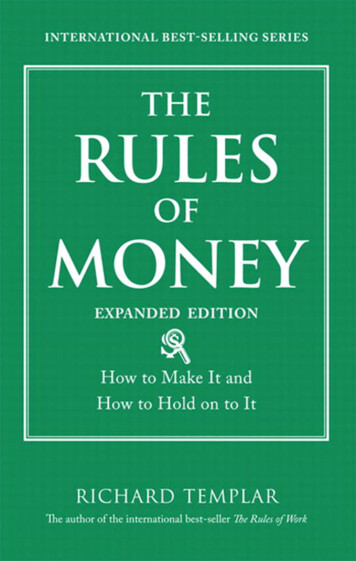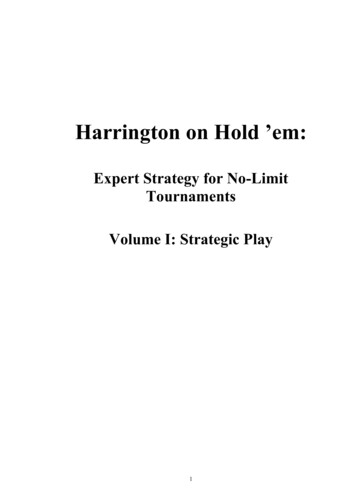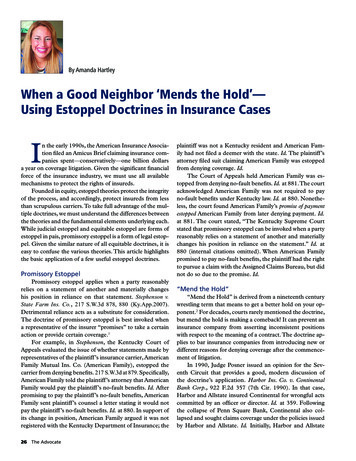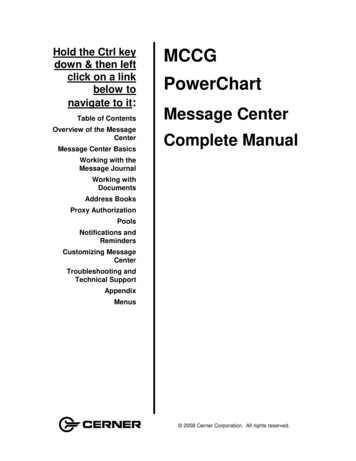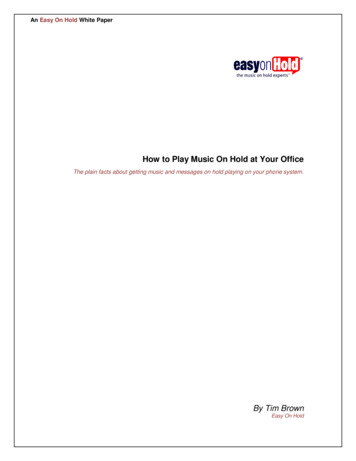
Transcription
Hold Me TightSeven Conversations for a Lifetime of Loveby Dr. Sue JohnsonWhat Is Emotionally Focused Couple Therapy (EFT)? Themessage of EFT is simple: Forget about learning how to argue
better, analyzing your early childhood, making grand romanticgestures, or experimenting with new sexual positions. Instead,recognize and admit that you are emotionally attached to anddependent on your partner in much the same way that a child ison a parent for nurturing, soothing, and protection. EFT focuseson creating and strengthening this emotional bond by identifyingand transforming the key moments that foster an adult lovingrelationship. EFT has an astounding 70 - 75% success rate and results havebeen shown to last, even in the face of significant stress. EFT isrecognized by the American Psychological Association asempirically proven.HOLD ME TIGHT presents a streamlined version of EFT. It walksthe reader through seven conversations that capture the definingmoments in a love relationship and instructs how to shape thesemoments to create a secure and lasting bond. Case histories andexercises in each conversation bring the lessons of EFT to life.Seven Transforming Conversations:Recognizing Demon Dialogues—In this first conversation,couples identify negative and destructive remarks in order to getto the root of the problem and figure out what each other isreally trying to say.Finding the Raw Spots—Here, each partner learns to lookbeyond immediate, impulsive reactions to figure out what rawspots are being hit.Revisiting a Rocky Moment—This conversation provides aplatform for de-escalating conflict and repairing rifts in arelationship and building emotional safety.Hold Me Tight—The heart of the program: this conversationmoves partners into being more accessible, emotionallyresponsive, and deeply engaged with each other.Forgiving Injuries—Injuries may be forgiven but they never
disappear. Instead, they need to become integrated into couples’conversations as demonstrations of renewal and connection.Knowing how to find and offer forgiveness empowers couples tostrengthen their bond.Bonding Through Sex and Touch—Here, couples find howemotional connection creates great sex, and good sex createsdeeper emotional connection.Keeping Your Love Alive—This last conversation is built on theunderstanding that love is a continual process of losing andfinding emotional connection; it asks couples to be deliberate andmindful about maintaining connection.Excerpt from Hold Me TightConversation 3: Revisiting a Rocky MomentAuntie Doris, a very large lady with peroxide hair and whiskerson her chin, was pouring rum over a huge Christmas pudding.She was also arguing with my almost inebriated Uncle Sid. Sheturned to him and said, “We is getting into a doozy here. One ofthem dead-end doozy fights we does. You are half cut and I sureas hell don’t feel like no shiny Christmas fairy. Are we going tofight it out? I’ll swing like always and you duck if you can. Bothfeel bad then. Do we need to do it? Or can we just start over?”Uncle Sid nodded solemnly, softly muttered “No doozy, noducking,” and then, “Lovely pudding, Doris.” He patted my aunton the backside as he tottered into the other room.I recall this little drama vividly because I knew that Uncle Sidwas going to be Santa Claus that night and any “doozy” probablymeant that I was going to be out of luck for presents. MyChristmas was saved by a compliment and a pat. But now, allthese years later, I see their interaction in another less selfcentered way. In a moment of conflict and disconnection, UncleSid and Aunt Doris were able to recognize a negative pattern,declare a ceasefire and re-establish a warmer connection.
It was probably pretty easy for Doris and Sid to cut short theirfight and change direction because, on most days, theirrelationship was a safe haven of loving responsiveness. We knowthat people who feel secure with their partner find it easier to dothis. They can stand back and reflect on the process betweenthem and they can also own their part in that process. Fordistressed lovers, this is much harder to do. They are caught upin the emotional chaos at the surface of the relationship, inseeing each other as threats, as the enemy.To reconnect, lovers have to be able to de-escalate the conflictand actively create a basic emotional safety. They need to beable to work in concert to curtail their negative dialogues and todefuse their fundamental insecurities. They may not be as closeas they crave to be, but they can now step on each other’s toesand then turn and do damage control. They can have theirdifferences and not careen helplessly into Demon Dialogues.They can rub each other’s raw spots and not slide into anxiousdemands or numbing withdrawal. They can deal better with thedisorienting ambiguity that their loved one, who is the solution tofear, can also suddenly became a source of fear. In short, theycan hold onto their emotional balance a lot more often and a lotmore easily. This creates a platform for repairing rifts in theirrelationship and creating a truly loving connection.In this conversation, you’ll see how to take charge of moments ofemotional disconnection, or mis-attunements, as attachmenttheorists call them, and tip them away from dangerous escalationand towards safety and security. To learn how to do this, I havecouples revisit rocky moments in their relationship and, applyingwhat they have learned in Conversations 1 and 2 about the waythey communicate and their attachment fears, figure out how tosmooth the ground. In my practice, we replay turbulent big-bangarguments as well as quieter continual disconnections. I slowdown the action, asking partners questions (“What just happenedhere?”), guiding them to key moments when insecurities spiraledand showing them how they could have cut their conflict shortand moved in a different and more positive direction.When Claire and Peter fight they don’t mess around. They qualifyfor the Oscar in marital spats. This time it starts with Claire
pointing out that Peter could have done more to help her duringher bout with hepatitis. “You just went on like nothing unusualwas happening,” she says. “When I suggested you do somechores, you were nasty and irritable. I don’t know why I shouldput up with that.”“Put up with!” exclaims Peter. “Oh, you don’t put up withanything as far as I can see. You make sure I suffer for everylittle error. Of course, it doesn’t count that I was working likemad on a big project. I am just one big disappointment to you!You make that perfectly clear. You weren’t so sick when youturned around and give me a lecture on the proper care ofbathrooms.” He turns his chair as if he is about to leave.Claire throws back her head and yells with frustration, “Littleerrors! Like the fact that then you frosted me out, wouldn’t talkto me for two days. Is that what you mean? A creep is what youare.” Peter, his face turned to the wall comments dryly, “Yeah,well this ‘creep’ doesn’t feel like talking to the task master.”Expert demolition of love relationship is now in progress.Now let’s replay this little drama and see how they can create anew kind of dance. Here are the steps that can set them on thepath to greater harmony:* Stopping the Game. In their argument, Claire and Peter weretotally ensnared in attack and defend, who is right, who iswrong; who is victim, who is villain. They are antagonists, usingthe pronouns “I” and “you” almost exclusively. “I am entitled tocaring here,” Claire belligerently declares, “And if you can’t stepup and do that, then I can do without you.” The victory is a littlehollow though since this isn’t what she wants. Peter quietlyresponds, “Can we stop this?. Aren’t we both defeated in thisspiral?” He has changed the pronoun to “we.” Claire sighs. Shechanges her perspective and her tone. “Yes,” she saysthoughtfully. “This is the place we always go to. We get trappedhere. We both want to prove our point so we do that till we endup totally exhausted.”* Claiming Your Own Moves. Claire complained that Peter tunedher out, that he didn’t try to hear her point when things got hot
between them. They name their moves together. Claire reflects,“It started with me complaining and getting very angry and you,what did you do?” “I got into defending myself, attacking back,”he replies. Claire continues, “And then I really lost it and accusedmore, really I was objecting to your withdrawing from me.”Peter, calmer now, risks a quip, “You missed a bit. Then youthreatened, remember? The bit about how you could do withoutme?”Claire smiles. Together they come up with a short summary oftheir moves: Claire loses it while Peter plays impervious; Clairegets louder and threatens, Peter sees her as impossible and triesto escape. Peter laughs, “The impervious rock and the bossybroad. What a conversation. Well, I can see that talking to a rockmust be frustrating.” Claire follows his lead and acknowledgesthat her angry critical tone probably triggers his defensivenessand contributes to his moving away after this kind of fight. Theyboth agree that it is hard to be honest.* Claiming Your Own Feelings. Claire is now able to talk abouther own feelings rather than, as she puts it, “focusing on Peterand disguising them in a big fat blame.” She shares, “There isanger here. Part of me wants to tell you, ‘Alright, if I am so hardto live with, I’ll show you. You can’t get to me.’ But I feel prettyshaky inside. Do you know what I mean?” Peter murmurs, “Ohyes, I know shaky.” Clear admissions like these of the roilingsurface emotions, of anger and confusion, are the beginning ofbeing accessible to your lover. Sometimes it helps to make theseadmissions by using the language of “parts.” This seems to helpus acknowledge aspects of ourselves that we don’t feel greatabout and also helps us express ambiguous feelings. Peter mightsay, “Yeah, part of me is numbed out here. It’s my automaticresponse when we get stuck like this. But I guess part of me isshaky, too.”* Owning How You Shape Your Partner’s Feelings. We need torecognize how our usual ways of dealing with our emotions, pullour partner off balance and turn on deeper attachment fears. Ifwe are connected, my feelings naturally will affect yours. Butseeing the impact we have on our loved ones can be very difficultin the moment when we are caught up in our own emotions,
especially if fear is narrowing the lens. In the fight, thingshappen so fast and Claire is so upset that she really does not seehow her critical tone and the phrase “put up with” hits Peter on araw spot and triggers his defensiveness. In fact, she states thathis behavior is all just about his personal flaws. He is a creep!In the moment, Peter does not see how his statement about notwanting to talk to the “task master” leads Claire to escalate intothreats about how she can do without him. To really take controlof Demon Dialogues and soothe raw spots, both partners have toown how they pull the other into negative spirals and activelycreate their own distress. Now Peter can do it. He says, “In thesefights, I defend and then stop talking. That’s when my shuttingdown gets you all freaked out isn’t it? You start to feel like I amnot here with you. I do shut down. I don’t know what else to do.I just want to stop hearing about how you are so angry withme.” * Asking About Your Partner’s Deeper Emotions. During thefight and the period of alienation that usually follows the fight,Peter and Claire are way too busy to tune into each other’sdeeper emotions and recognize that they are touching on eachother’s raw spots. But when they can look at the big picture andslow down a little, they can begin to be curious about the other’ssofter, underlying emotions, rather than just listening to theirown hurts and fears and assuming the worst about their lover.Now Peter turns to his wife and says, “I get into thinking that youare just out to put me down. But in these situations, you are notjust mad are you? Under all that noise and raging you arehurting, aren’t you? I get that now. I know your sensitive spot isabout being left and abandoned. I don’t want you to hurt. Iguess, I used to just see you as the righteous principal busyproving how useless I was as a spouse.” When Claire asks Peterabout the softer feelings that came up for him in this fight, he isable to look inside and pinpoint how the phrase “put up with”ignited all his fears of failure.And Claire then, remembering their raw spot conversations, addson, “So it’s like whatever you do, I am going to be disappointed.And that feels so bad, you just want to give up and run.” Peteragrees. Of course, it really helps here if partners have been ableto be really open about their raw spots in previous conversations,
but assuming you have a big impact on your partner and beingactively curious about his or her vulnerabilities helps too.* Sharing Your Own Deeper, Softer Emotions. Voicing yourdeepest emotions, sometimes sadness and shame, but mostoften attachment fears, may be the most difficult step for you,but it is also the most rewarding. It lets your partner see what’sreally at stake with you when you argue. So often we miss theattachment needs and fears that lie hidden in recurring battlesabout everyday issues. Unpacking moments of disconnection likethis helps Claire explore her own feelings and risk sharing themwith Peter. Claire takes a deep breath and says to Peter, “I amhurting but it’s hard to tell you. I have this sense of dread. I canfeel it like a lump in my throat. If I stopped coming to you, tryingto get your attention, you might just watch us drift off into moreand more separateness. You might just watch our relationshipfade out, go off the screen. And that is scary.” Peter listens andnods. He tells her, “It helps me when you risk telling me that. Ifeel like I know you in a different way when you say things likethat. Then you are more like me somehow. It’s easier to feelclose. And it makes me want to reassure you. I may zone outsometimes but I wouldn’t let you drift away from me.”* Standing Together. Taking the above steps forges a renewedand true partnership between lovers. Now a couple has commonground and common cause. They no longer see each other asadversaries, but as allies. They can take control of escalatingnegative conversations that feed their insecurities and face thoseinsecurities together. Peter tells his wife, “I like it when we canstop and turn down the volume. I like it when we both agreedthat this conversation was too hard, that it was out of hand, andscaring both of us. It feels very powerful for us to agree that wewere not going to just get stuck the way we usually do. Even ifwe are not quite sure where we go next, this is a lot better. Wedon’t have to get caught in that stuck place all the time.”All this doesn’t mean that Peter and Claire feel really tuned intoand connected with each other in a secure bond. But it doesmean that they know how to stop a rift before it widens into anunbridgeable abyss. They are aware of two crucial elements ofde-escalation: first, that how a partner responds at a key
moment of conflict and disconnection can be deeply painful andthreatening to the other, and second, that a partner’s negativereactions can be desperate attempts to deal with attachmentfears.Couples won’t always be able to apply this knowledge and thespecific steps of de-escalation every time they disconnect. Ittakes practice, going over an unsettling past encounter again andagain until it makes coherent sense and, unlike the originalevent, can draw a possible supportive response from the otherpartner. Once couples have mastered that, they can begin tointegrate these steps into the everyday rhythm of theirrelationship. When they argue or feel distanced from each other,they can take a step back and ask, “What’s happening here?”They won’t always be able to do it; the heat may be too high atcertain times. Normally, when my husband misses my signalingfor connection, I can step back and reflect on our interaction. Iam still balanced and can choose how to respond. Butsometimes, I suddenly become so raw and vulnerable that theuniverse instantly narrows down into what feels like a life anddeath struggle. I react harshly to create some sense of control,to limit my helplessness. All my husband sees is my hostility.When I’m calmer, I search him out. “Hmm, can we just go backand do that again?” I ask. Then we press the mental rewindbutton and replay the incident.By doing this sort of thing over and over, couples develop a finesense of when they’re stepping onto faulty territory. They feelthe ground shaking sooner and they are able to escape it faster.They develop confidence in their ability to take charge ofmoments of disconnection and so shape their most preciousrelationship. It will take a while though before most couplesdevelop the abbreviated, almost shorthand, de-escalationlanguage of Auntie Doris and Uncle Sid.Recognizing Your Impact on Your PartnerKerrie and Sal provide a detailed example of the ins and out ofthe de-escalation process. An upwardly mobile, cool-lookingcouple who have been married for 20 years, the only thing they
agree on is that the last four have been “hell.” They’recontinually getting into a negative spiral over the fact that Kerrie,busy with a new career after years of being a stay-at-homemom, is coming to bed much later than Sal. They have triednegotiating about this but deals get made and broken.They have been sniping at each other for about ten minutes inmy office. I ask if this sniping is the usual way they relate toeach other. Kerrie, a tall, elegant woman dressed all in red,including her Italian leather briefcase, told me incisively, “No.Usually I just stay real calm. I prefer politeness. And I go off intomy head when he does his aggressive thing. But just recently Ihave felt more and more cornered, so I just come out swingingto get him to back off for a while.” I suggest that the mutualattack cycle I was seeing was then maybe a minor deviation froma pattern of Kerrie holding back emotionally and Sal trying to getsome sense of control and engage his wife more. They agree.Sal, an articulate corporate lawyer with a touch of gray at histemples, launches into a diatribe about how deprived he is in thismarriage. He is offered no affection, attention, or sex. He is notlistened to. He is mad and he is entitled to be mad. Kerrie raisesher eyes to heaven, crosses her legs and begins to wave her redhigh-heeled clad foot up and down. I point out how the pattern isoccurring right here. He is getting mad and demanding attention.She is giving “You can’t get to me” signals.Kerrie breaks the tension here, openly laughing as sherecognizes her own strategy. Sal then offers a few insights intohow Kerrie’s upbringing has damaged her ability to be empathicand some advice about how she can address that. Kerrie ofcourse hears only that she is the problem and must work to fixher deficiencies. The tension returns.We talk a little about attachment and love and how our primalprogramming dictates that when Sal feels disconnected, he willaggressively reach for Kerrie, and she, seeing only his anger, willdefensively withdraw to try to calm herself and the relationship.This basic “It’s not your inadequacies, it’s how we are wired”message seems to help a lot.
This couple’s pattern of “You will listen/You can’t make me” hadbeen in place throughout their marriage but had become morepowerful and toxic once Kerrie had started her successful careeras a real estate broker. Each began to fit their fights, rifts andeveryday hurts into this pattern. In an intellectual sense they getthat this pattern now runs their relationship and that they bothend up being, as Sal puts it ,“victims of the vortex.”But there was something missing. It is clear that Kerrie sees Salthrough a narrow prism of distrust. She does not reallyunderstand the impact her distancing has on him in the here andnow and how it pulls him into their cycle. She doesn’t truly seehow she unwittingly shapes his response to her.At one point she turns to him and asks pointedly, “So why is itthat you get so pushy then? Okay, so there is this wired-in needfor contact and I can be kind of cool, that is my style. But I havebeen a pretty good wife to you. Don’t you think so?” Sal nodssolemnly, staring at the floor. “But like this morning, you justlaunched into this thing about how busy I am, how I didn’t cometo bed till late last night. This is a real issue with us. It comes upall the time. If I don’t go to bed with you or come later than youwant, you go ballistic. There is something I don’t get here. It’slike nothing matters except what you want in that moment, evenif we have had time together during the day.”Sal starts into an elaborate set of points about how he is notreally so demanding. Kerrie is off in some other world before hefinishes his first rational sentence.We need to change level of dialogue here and get a little moreemotional engagement. I ask him if he remembers how he feels,waiting for Kerrie to come to bed. He takes a moment and thenretorts. “Oh, it’s great waiting for your wife all the time.Wondering if and when she is going to deign to turn up!” At firstglance, he looks like just what he is, a man used to being incharge of a huge law firm and having people jump to please him.But underneath the reactive anger, I hear the doubt about her“turning up” to be with him.I ask, “What is happening to you right now as you speak about
this? You sound angry but there is a bitterness here behind thesarcasm. What does it feel like to be waiting for her, feeling thatshe does not care how long you wait or may not come at all?” Ihave pushed the down elevator button. After a long silence, heanswers.“It is bitter,” Sal admits. That’s the word. So I turn it into straightanger. But what does it feel like to be waiting?” And suddenly hisface crumples. “It’s agonizing, that is what it is.” He covers hiseyes with his hand. “And I can’t handle feeling that way.”Kerrie moves her head back in surprise. She furrows her brow indisbelief. In a soft voice, I ask Sal to help me understand theword “agonizing.” As he starts to speak, all traces of Sal, theterror of the courtroom, fade away. “It seems to me that I amalways on the edge of Kerrie’s life,” he says. “I don’t feelimportant to her at all. She fits me in the cracks in her busyschedule. We used to always be close before going to sleep. Butnow when she doesn’t come to bed for hours, I just end upfeeling pushed aside. If I try and talk about it, I just getdismissed. Lying in bed by myself, I go into feeling sounimportant. I don’t know what happened here. It wasn’t alwayslike this. It feels like I am all by myself here.”I pick up on the words “by myself” and “pushed aside” and hissense of loss. I remember listening to him talk in the first sessionabout his lonely childhood, mostly spent in expensive boardingschools, while his diplomat parents traveled the world. Iremembered him telling me that Kerrie is the only person he hasever felt close to or trusted and that finding her had opened awhole new world for him. As I reflect these thoughts and his ownwords back to him, I legitimize his pain. Then I ask how it feelsright now to talk about these difficult feelings of being pushedaside. He continues, “It feels sad and kind of hopeless.”I ask, “Is it like some part of you says that you have lost yourplace with her? You aren’t sure how important you are to Kerrieanymore?” “Yes,” Sal’s voice is very quiet. “I don’t know what todo, so I get mad and make lots of noise. That’s what I did lastnight.” I comment, “You are trying to get Kerrie’s attention. Butyou feel hopeless. It is scary for most of us when we are unsure
of our connection, when we cannot get the person we love torespond to us.” “I don’t want to feel this way,” Sal adds. “But youare right. It is scary. And it’s sad. Like last night, I lay there inthe dark and my mind said, ‘She is busy. She can take her time.’And here I am, I feel like some kind of pathetic fool.” As he saysthis, his eyes fill with tears.And this time when I look at Kerrie, her eyes are wide open. Shehas leaned forward towards her husband. I ask her how she isreacting to the things her husband is sharing. “I am reallyconfused here,” she says, and turning to Sal, she asks,” Are youserious? You are. You get mad at me because you don’t feelimportant to me! You feel alone? I have never ever seen that inyou. I have never imagined ” Her voice trails off for a fewseconds. “I just see this belligerent man out to get me.”We talk about how strange it is for her to hear about how herbeing less accessible impacts him and that he now lives in aworld where he misses her and is scared that he has lost hisplace with her. “I really understand that you would see me thatway,” Sal goes on. “I do try to stay away from these feelings. It’seasier to just get angry or sarcastic, so that is what you see.”Kerrie looks like she is struggling here. Her husband is not theman she thought he was. I cannot resist pointing out that Sal’sanger pushes Kerrie away and as she distances they both stepinto a spiral of insecurity and isolation.“I really didn’t know you felt that way,” says Kerrie. “I didn’tknow that my staying apart, trying to avoid all the angryexchanges I never knew you were waiting for me and feeling sohurt. I didn’t know how painful that was for you. That it matteredto you so much that I come to bed. When we fight it sounds likeit is all about how you want more sex.” Now her face and hervoice have softened. Then in an amazed whisper she says, “Ididn’t know I mattered that much to you? I just thought youwanted to be in control.”I asked her if she could see that her distancing to avoid Sal’sanger switched on his attachment fears, touched him on a rawspot and triggered his anger, pulling him into the spiral of
distress.“Yes, I see that.” She acknowledges. “I guess that is why hecan’t just decide to stop being so angry, even when we havediscussed it and how I don’t like it. I guess I’m hearing how mystaying distant and busy sparks all those feelings in him. Andthen his anger is too much for me and I run away more. Andthen we are stuck.” She turns to Sal. “But I.I never knew youwere waiting alone in the dark for me. I never got that I had thatimpact on you. I just didn’t see that. That you might be feelingalone in the dark.”Kerrie and Sal are really beginning to see the power they haveover each other on an emotional attachment level. They canbegin to grasp how each of them triggers the other’s fears andkeeps their Protest Polka going. He protests her distance. Sheprotests his aggressive ways of trying to connect with her. Saland Kerrie start to see, in a concrete way, how they hook eachother into their negative amazon.com
HOLD ME TIGHT presents a streamlined version of EFT. It walks the reader through seven conversations that capture the defining moments in a love relationship and instructs how to shape these moments to create a secure and lasting bond. Case histories and exercis




